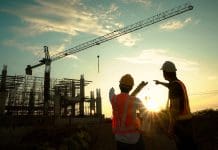Sarah Nelson, CEO, Foundation for Future London, discusses a more participatory planning approach to 15-minute neighbourhoods
In urban areas – where there is a need for accessible and adequate facilities and services enhanced accessibility and improved facilities – residents can often face challenges in accessing benefits that contribute to a healthy and fulfilling life, including community and social cohesion and places for regular exercise.
In response, the idea of 15-minute neighbourhoods has increasingly gained ground. An innovative approach to urban planning and development, it envisions creating compact and accessible urban areas where residents can meet their basic needs within a 15-minute walk or cycle from their homes.
The 15-minute neighbourhood is already being seen across the world in cities such as Paris, Shanghai and Melbourne, as well as several London boroughs.
Take Newham, for example, where the borough aims to grant people access to housing, grocery shops, childcare, schools, healthcare facilities, recreational spaces, cultural hubs and public transport through a 15-minute neighbourhood scheme.
The model aims to enhance quality of life by reducing reliance on cars, cutting commute times, and promoting a more sustainable and environmentally friendly lifestyle. In turn, this extends to fostering safer, more vibrant communities.
In some cases, this increased community ownership and a more connected society can even lead to reduced crime.
But are they achievable?
How does the 15-minute neighbourhood transform urban living?
At its core, the 15-minute neighbourhood is built on three transformative pillars: accessibility, sustainability and community engagement:
Live healthier and greener
With work, essential services and amenities within easy reach, 15-minute neighbourhoods promote a healthier lifestyle through increased physical activity and improved mental well-being. This transformation can already be seen in Newham, where residents are encouraged to walk, wheel, cycle or run by redeeming a digital currency just by moving.
The BetterPoints Newham programme, funded by the Westfield East Bank Creative Futures Fund, means that users can accrue rewards to be spent at businesses in Newham, or donated to charity, helping to make a local difference.
Stay flexible and resilient
Designed to adapt to future challenges, the 15-minute neighbourhood model hopes to offer a resilient framework that secures improved area conditions for generations to come.
Strengthen community ties
Through active community participation from the design phase to development, this approach fosters a strong sense of belonging and ownership among residents.
The foundation for a participatory approach to designing 15-minute neighbourhoods lies in this last pillar.
Ensuring inclusivity through community engagement
Local communities should be involved from the start of any urban planning and design process: this ensures that neighbourhoods are inclusive and equitable.
When local voices are heard, the final development is far more likely to meet the actual needs and expectations of those it’s intended to serve.
Engaging with the community early allows potential issues and conflicts to be identified and addressed before they become significant roadblocks, saving valuable time and resources down the line.
It’s also a way of making sure that diverse perspectives – especially from marginalised or under-represented groups – are heard and recognised.
By offering educational and participatory experiences for community members, residents are encouraged to learn new planning skills and local talents can be discovered for current and future projects.
East London’s approach to equitable regeneration
We’ve seen a general embrace of the philosophy of community-led development on major regeneration projects through the work we’ve done in East London. The area’s approach goes beyond just physical redevelopment to creating opportunities for economic growth among its population, in a way that’s inclusive and community based.
As a result, significant investments have been made in improving public infrastructure like transport links and community services. There’s also been a strong emphasis on sustainability within redevelopment in the area, incorporating green building practices, renewable energy and sustainable drainage systems.
Green spaces and natural habitats have been integrated into the urban planning of the area, helping to enhance biodiversity and provide residents with accessible natural environments.
A great example of this is the unique open-access community-led Abbey Gardens in Newham. The open-access community in East London, is funded in partnership with Westfield Stratford City, has given local residents a green space to meet, hold events, grow plants and vegetables and celebrate the community.
Facing the challenges
While the 15-minute city model offers many benefits, it has faced some criticisms. They include:
Loss of personal freedom
Some argue the model could restrict personal freedom by confining people to their local neighbourhoods.
However, the goal is accessibility and sustainability — not isolation. Residents can still travel further afield as needed.
Inclusive, accessible designed communities also benefit from the advantages that come with showcasing culture, heritage and community pride. One advantage, encouraging visitors, can also act as a boost to the economy of the neighbourhood.
Gentrification and displacement
Introducing 15-minute neighbourhoods does risk gentrification if not managed carefully, with increased amenities potentially driving up property values and displacing lower-income residents.
Robust policies and community protections are needed here. This, again, can be carried out inclusively by involving communities as agents of change and enabling residents to take ownership of the spaces in which they live.
Reduced diversity
There are concerns neighbourhoods could become insular and culturally or socially homogeneous under this model. Again, thoughtful planning and an embrace of diversity can mitigate this. Interventions such as capacity building and training opportunities can ensure a wider mix of people have a seat at the table to ensure inclusive planning.
Foundation for Future London has seen first hand how this could work, through the New Talent Future Leaders programme, which aims to support diverse young people into work and create inclusive opportunities for East London’s diverse workforce. The programme, funded through the Westfield East Bank Creative Futures Fund, will set a solid future for young demographics to thrive in East London and beyond.
Environmental impacts:
Though a core aim is reducing carbon footprints, some critics assume densification and development will lead to more pollution and loss of green space. In reality, the model emphasises sustainable growth while adding parks and natural areas.
Ultimately, 15-minute neighbourhoods can boost quality of life
The 15-minute neighbourhood model is an innovative way to improve quality of life in cities, while supporting sustainability goals.
By creating compact neighbourhoods with easy access to amenities, reliance on cars is reduced while active lifestyles and community bonds are encouraged.
However, we must plan these developments in line with the community from the very start.
This ensures the needs of all residents are prioritised and that regeneration benefits everyone equitably. That way, 15-minute neighbourhoods can unlock tremendous potential for more liveable, sustainable and vibrant urban areas.








![[VIDEO] Local planning inspector recruitment to begin in earnest in new year A drive to recruit local planning inspectors will begin in the new year](https://www.pbctoday.co.uk/news/wp-content/uploads/2025/12/iStock-2159482095-2-218x150.jpg)




